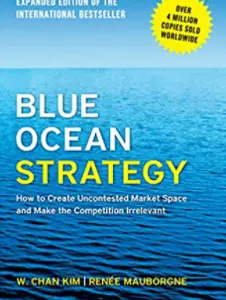What should you do when a competitor lowers their price? Or when they introduce a better product? In these situations, Business School has taught us to fight harder and win market share back. That’s to highlight the similarities between war and business. Competition is fierce and we want to dominate the fight. But the Blue Ocean Strategy flips the narrative.
Blue Ocean Strategy is a book on business strategy that underscores the importance of uncontested market spaces. Here are some takeaways and ties to business economics.
Page Contents
Red Ocean vs Blue Ocean
Operating a business is like fighting a war, and the struggle can be destructive. In a competitive market, companies try to differentiate themselves in hopes of gaining new customers and market share. Authors Chan Kim and Renee Mauborgne call this traditional business context a Red Ocean, an ode to blood in the water.
The difference between a Blue Ocean and Red Ocean strategy is the setting of the scene. A Red Ocean strategy is focused on winning market share by fighting harder.
A Blue Ocean strategy, in contrast, calls for creating a new field with no competition. It’s not focused on winning market share through differentiation. It is focused on creating a new market.
Blue Ocean strategy examples
The circus, of literal animals and clowns, was a dying industry with declining profits and a decreasing audience base. There have been cries of animal abuse and people simply preferred other activities. In the midst of their decline, Cirque du Soleil came out with an apparent revolution. As a combination of the circus and the opera, people were willing to pay premium tickets, and sales shot up. This is an example of creating a new market.
Airbnb did the same in the travel accommodation industry. Uber as well with transportation. Apple has done it time and again with its products.
The Why and How of Blue Ocean strategies
As the sole player of a new market, you’re by definition the monopoly. Even in competitive markets, businesses differentiate themselves and strive for monopolistic shares. That’s because profitability increases exponentially when transitioning from a competitive market to a monopoly.
In Red Ocean competitive markets, prices adjust to a point where economic profit is zero (perfect competition). This means the price is set where it equals marginal costs.
On the other hand, a monopoly can set prices above marginal costs. This allows them to earn an economic profit. (Wikipedia) Monopolies have a first-mover advantage as well. This makes it hard for new competitors to come in. And this also means prolonged periods of positive economic profits for your business.
A Blue Ocean Strategy doesn’t stop with knowing your competitors. It also implies studying businesses in adjacent niches. A business in the wine industry might look at competitors and customers in the beer market.
Kim and Mauborgne suggest focusing on what you can eliminate, reduce, improve (raise), or create out of the adjacent markets. They list 6 basic approaches to remaking boundaries:
- Alternative industries; airline to the car industry; cinema to the restaurant industry)
- Strategic Groups within Industries; luxury vs. economy cars
- Chain of Buyers; IT department vs. financial analysts (Bloomberg’s case)
- Complementary Products and Service Offerings
- Functional or Emotional Appeal to Buyers
- Look Across Time
(Buy the ebook or audiobook on Amazon.)
Conclusion
The message of Blue Ocean Strategy is short but valuable.
Stop trying to beat the competition. Start focusing on making the competition irrelevant.
Finding your Blue Ocean is guaranteed to be a challenge. But if you do, it’s guaranteed to be well worth the effort.
*This post may contain affiliate links. You can read my affiliate disclosure here, Terms & Conditions, #6 Links.









